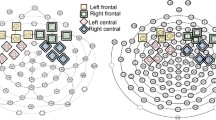Abstract
Compared 8- to 14-year-old children with either autism or receptive developmental language disorder (RDLD) to age- and IQ-matched normal controls in their ability to detect both frequent (p=.70) and infrequent (p=.30) randomly presented auditory stimuli under task and no-task conditions. Event-related brain potentials (ERPs), behavioral reaction times, and target detection accuracy rates were measured. Although the three groups of children performed in a similar manner on behavioral measures, only the children with autism demonstrated an abnormally small amplitude of the P3b, a component of the ERP. This result is interpreted in terms of (a) the consistency of this finding with other ERP studies involving older individuals with autism; and (b) its significance with respect to the difficulty children with autism have in modifying their expectancies to contextually relevant sequences of auditory information.
Similar content being viewed by others
References
American Psychiatric Association. (1987).Diagnostic and statistical manual of mental disorders (3rd ed., rev.). Washington, DC: Author.
Beery, K. E. (1984).Revised administration, scoring and teaching manual for the Developmental Test of Visual-Motor Integration. Cleveland, OH: Modern Curriculum.
Ciesielski, K. T., Courchesne, E., & Elmasian, R. (1990). Effects of focused selective attention tasks on event-related potentials in autistic and normal individuals.Electroencephalography and Clinical Neurophysiology, 75, 207–220.
Courchesne, E., Elmasian, R., & Yeung-Courchesne, R. (1987). Electrophysiological correlates of cognitive processing: P3b and Nc, basic, clinical and developmental research. In A. M. Halliday, S. R. Butler, & R. Paul (Eds.),A textbook of clinical neurophysiology (pp. 645–676). London: Wlley.
Courchesne, E., Kilman, B. A., Galambos, R., & Lincoln, A. J. (1984). Autism: Processing of novel and auditory information assessed by event-related potentials.Electroencephalography and Clinical Neurophysiology, 59, 238–258.
Courchesne, E., Lincoln, A. J., Kilman, B., & Galambos, R. (1985). Event-related brain potential correlates of the processing of novel visual and auditory information in autism.Journal of Autism and Developmental Disorders, 15, 55–76.
Courchesne, E., Lincoln, A. J., Yeung-Courchesne, R., Elmasian, R., & Grillon, C. (1989). Pathophysiologic findings in nonretarded autism and receptive developmental language disorders.Journal of Autism and Developmental Disorders, 19, 1–17.
Courchesne, E., & Yeung-Courchesne, R. (1987). Event-related brain potentials. In M. Rutter, A. H. Tuma, & J. S. Lann (Eds.),Assessment and diagnosis in child psychopathology (pp. 264–299). New York: Guilrord.
Dawson, G. (1991). A psychobiological perspective on the early socio-emotional development of children with autism. In D. Cicchetti & S. Toth (Eds.),Rochester symposium on developmental psychopathology: Vol. 3. Models and integrations. (pp. 207–234). Rochester, NY: University of Rochester Press.
Dawson, G., Finley, C., Phillips, S., Galpert, L., & Lewy, A. (1988). Reduced P3 amplitude of the event-related brain potential: Its relationship to language ability in autism.Journal of Autism and Developmental Disorders, 18, 493–504.
Dawson, G., & Lewy, A. (1989). Arousal, attention and socioemotional impairments of induviduals with autism. In G. Dawson (Ed.),Autism: Nature, diagnosis and treatment. (pp. 49–74). NY: Guilford.
Dunn, L., & Dunn, L. M. (1981).The Peabody Picture Vocabulary Test-Revised. Circle Pines, MN: American Guidance Service.
Hammill, D. D., & Newcomer, P. L. (1988).Tests of Language Development-2: Intermediate. Austin, TX: Pro-Ed.
Hillyard, S. A., & Picton, T. W. (1987). Electrophysiology of cognition. In F. Plum (Ed.),Handbook of physiology-the Nervous System: Vol. 5. Higher functions of the brain: Part 2 (pp. 519–584). Bethesda, MD: American Physiological Society.
Jastak, S., & Wilkinson, G. S. (1984).The Wide Range Achievement Test-Revised: Administration manual. Wilmington, DE: Jastak Associates.
Johnson, R., Jr. (1988). The amplitude of the P300 component of the event-related potential: Review and synthesis. In P. K. Akeles, J. R. Jennings, & M. G. H. Coles (Eds.), Advances in psychophysiology (Vol. 3, pp. 69–138). Greenwich, CT: JAI.
Johnson, R., Jr., & Donchin, E. (1982). Sequential expectancies and decision making in a changing environment: An electrophysiological approach.Psychophysiology, 19, 183–200.
Kanner, L. (1943). Autistic disturbances of affective contact.Nervous Child, 2, 217–250.
Lincoln, A. J. (1980).The development of selective responsiveness in infancy. Doctoral dissertation, California School of Professional Psychology, San Diego.
Niwa, S., Ohta, M., & Yamazaki, K. (1983). P300 and stimulus evaluation process in autistic subjects.Journal of Autism and Developmental Disorders, 13, 33–42.
Novick, B., Kurtzberg, D., & Vaughn, H. G., Jr. (1979). An electrophysiologic indication of defective information storage in childhood autism.Psychiatry Research, 1, 101–108.
Novick, B., Vaughn, H., Kurtzberg, D., & Simson, R. (1980). An electrophysiologic indication of auditory processing deficits in autism.Psychiatry Research, 3, 107–114.
Oades, R. D., Walker, M. K., Geffen, L. B., & Stern, L. M. (1987). Event-related potentials in autistic and healthy children on an auditory choice reaction time task.International Journal of Psychophysiology, 6(1), 25–37.
Pritchard, W. S. (1981). Psychophysiology of P300.Psychological Bulletin, 89, 506–540.
Pritchard, W. S., Raz, N., & August, G. (1987). Visual augmenting/reducing and P300 in autistic children.Journal of Autism and Developmental Disorders, 17, 231–242.
Semel, E., Wiig, E. H., Secord, W., & Sabers, D. (1987).CELF-R: Clinical Evaluation of Language Fundamentals-Revised. New York: Psychological Corp.
Stern, D. N. (1977).The First relationship: Infant and mother. Cambridge, MA: Harvard University Press.
Regan, D. (1989).Human brain electrophysiology: Evoked potentials and evoked magnetic fields in science and medicine. New York: Elsevier.
Wechsler, D. (1974).Wechsler Intelligence Scale for Children-Revised. New York: Psychological Corp.
Author information
Authors and Affiliations
Additional information
Supported by NINCDS grant R01-NS26814-01 awarded to Alan Lincoln. The senior author thanks the San Diego Regional Center and the San Diego Unified School District for their continued assistance and support.
Rights and permissions
About this article
Cite this article
Lincoln, A.J., Courchesne, E., Harms, L. et al. Contextual probability evaluation in autistic, receptive developmental language disorder, and control children: Event-related brain potential evidence. J Autism Dev Disord 23, 37–58 (1993). https://doi.org/10.1007/BF01066417
Issue Date:
DOI: https://doi.org/10.1007/BF01066417




